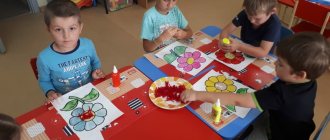Applications for children are one of the most favorite games and fun. But it’s by playing that the little ones learn! They gradually become accustomed to the world of colors and shapes. And they also get satisfaction from the fact that they themselves, with their own hands, can create beauty. And if parents want to help their child, we will give you ideas for appliqué made from colored paper.
What we can offer:
- Schemes and stencils for applications of different figures: flowers, animals, insects and fairy-tale characters.
- We'll show you what interesting, non-traditional appliqué techniques there are.
- And, of course, we will give you a lot of positive emotions! We are sure you will have fun with us!
And most importantly, all these children's applications are for toddlers of different ages. And in one year the child will be interested in playing, and the older one will enjoy this activity. Why? Because we have prepared a collection that includes applications for children with different abilities.
The essence of the application: goals and objectives in the middle group
Applique is a type of isotechnics that is based on the creation of a plot composition using paper, fabric parts, elements made from natural materials, cereals or grains, located and glued/sewn onto a dense backing - cardboard, paper or draped with fabric.
In the middle group, children become more independent when performing appliqué
The mission of appliqué classes is as follows:
- enriching children's ideas about the world around them, in particular about the concepts of shape, shades of colors, an initial understanding of proportionality and the arrangement of elements in a limited space (on a sheet of paper or cardboard);
- forming the basis of critical thinking, that is, the ability to compare, generalize, and draw simple conclusions;
- development of logic, imaginative thinking, speech through composing stories based on applications;
- hand motor skills training;
- awakening a taste for creative work, the desire to harmonize color and shape in holistic subjects;
- nurturing initiative, self-organization and the ability to work with a partner or in a group.
The objectives of classes in this type of visual creativity in the middle group are:
- mastering the skill of straight cutting in different (!) directions, as well as with elements of creating rounded shapes by cutting off the corners of a square;
- developing the ability to combine elements to obtain a complete composition (if you put squares on top of each other, you get a tower, and if you place a triangle over a square, you get a house);
- training in composing plots from geometric shapes of different sizes (10–12 parts), in particular in the shape of a triangle, circle, square, rectangle;
- developing the skill of finding aesthetically attractive combinations of appliqué with other types of art;
- develop the skill of working in pairs;
- develop the ability to evaluate your work.
Children learn to work just side by side, and in pairs, mini-groups
New appliqué skills for the middle group
The main “acquisition” of middle preschool age is training in the ability to use scissors. In addition, children 4–5 years old:
- arrange and glue plot elements onto a base that has an irregular shape;
- learn to form parts of the required shape and size by cutting off corners, cutting an element around the entire perimeter or only from the bottom/top/right/left, for example, making a circle by cutting off the corners of a square;
- improve the cut-off appearance of the applique, including during the preparation of materials (cut off or tear off the corners of the rectangle so as to give the workpiece a square shape, etc.).
What and how to make an applique from leaves
What we need:
- 1. Natural material: leaves of various sizes, shapes and colors (they can be dried in advance), twigs, flowers, herbs, seeds.
- 2. Colored paper, felt, glue, scissors, paints, pencils, cardboard.
- 3. Varnish can also be useful to fix the finished work and give it shine.
How to work with leaves:
To start working on crafts from leaves, they must first be dried. This can be done between the leaves of books, or using an iron. Store the leaves between the pages of books or newspapers.
Place of appliqué lessons in the educational program for the middle group
Application is not only a separate lesson in the artistic and aesthetic cycle of lessons, which includes a detailed consideration of the topic and the implementation of application in one technique or another, but also:
- a way to consolidate the learned material in classes within other educational vectors (for example, in a lesson on speech development on the topic “My City,” children make a geometric appliqué “My Street”);
- assignment of project work (for example, kids, together with their mothers and fathers, make an application on the topic “Unusual professions,” which is accompanied by a story about the specialist presented in this way);
- the essence of the activities of the art activity circle.
For children 4–5 years old, an appliqué club is possible only if the group is mixed - middle-high, since in the middle group the applique club gives way to a drawing circle.
How is the time spent working on the application distributed in the middle group?
A lesson within the framework of a creative course of the educational process lasts 20 minutes, and all this time is allocated for preparation - up to 3 minutes, execution - up to 12 minutes, and evaluation of the application - up to 3 minutes (the remaining minutes are left for organizing the work of the group). Finger gymnastics is introduced into the preparation stage, and at the stage of performing crafts there is a mandatory (!) physical education break - up to 2 minutes.
Finger gymnastics is a mandatory element of appliqué classes.
If the application is a separate type of work in non-creative lessons, then a quarter of the class time is usually allocated for its implementation. As a rule, the application is part of the stage of consolidating the material, that is, it is performed at the end of the lesson.
Typically, a project, the ultimate goal of which is to complete an application, in the average group is limited to a fairly large time period - from two days to a week. In addition, the project requires the active assistance of parents. However, if a project application is a task that is performed during the educational process in a group, then the timing of its creation will be the same as in a regular lesson.
Work on applications in a circle activity can be carried out according to a lesson or project scenario, depending on the topic of the lesson.
What is the teacher's participation?
When working with children 4–5 years old, the teacher voices the task, shows a sample, and then gradually completes the task, which the children repeat step by step. In addition, the teacher:
- provides practical individual assistance with the implementation of individual details of the composition, for example, cutting out small details (for example, grape leaves in the “Fruit on a Plate” appliqué);
- helps to arrange the elements of the composition on the substrate;
- controls the accuracy of applying glue and pressing down elements;
- gives recommendations on the most harmonious use of decorative elements (for example, for a paper “Matryoshka”, sundress decorations can be made of plasticine and buttons, but rhinestones and sequins will violate the style of the folk costume).
Video: teacher’s activities during an application lesson on the theme “Tulips” in the middle group
What artistic techniques can the applique be combined with?
By the middle group, children are familiar with all visual techniques designated as software in the Federal State Educational Standard (FSES). However, the level of proficiency in many of them is still low. For example, design is mastered at the initial stage. Therefore, the application can only be combined with a drawing or plasticineography.
Photo gallery: examples of combinations of applications with other types of isotechnics
In order for the work to look neat, there should not be a lot of plasticine elements. In some crafts, not only isotechniques are combined, but also different types of applique. Children of the middle group can make drawn additions to the applique in the form of non-solid elements themselves.
Table: types of applications for children of middle preschool age
| Technique | Application type, material | Features of use in the middle group |
| Traditional | Flat - solid elements cut out of paper are glued onto a backing. | In the second youngest group, children used the parts that the teacher prepared; in the middle group, they cut out large parts themselves without unnecessary bends. In addition, children 4–5 years old master the skills of multi-layer appliqué, when parts overlap one another. |
| Mosaic - cut pieces of paper are laid out within the boundaries of the design. It is mastered in parallel with the tape one. | On a mosaic applique, children practice direct movement with scissors to cut out parts. The ribbon type involves children folding paper like an accordion and then cutting it into pieces. | |
| Geometric - the composition is made up of elements of geometric shape. | Children aged 4–5 years practice laying out plots in triangles, squares and rectangles of different sizes. Last year, parts of the same shape were used to create compositions; in the middle group, kids combine several. | |
| Unconventional | From napkins - elements or individual parts are made from napkins, often folded in several layers to give the image volume. | In the middle group, children learn to fold napkins to create a multi-layered piece. |
| Tear - paper or napkins are torn into pieces of different sizes, which are then used to lay out the picture. | The type of appliqués familiar from last year in the middle group can be complicated by the fact that children twist balls from torn parts with their palms, which are then laid out in mosaics along the contours of the image. | |
| From cotton wool or cotton pads - the image is filled with pieces of cotton wool or discs (whole or cut). | In the middle group, cotton wool and discs become an additional element of other types of applications. | |
| Palm - the composition is made up of children’s palms outlined and cut out. | The teacher is responsible for cutting out palms, since children 4–5 years old do not use scissors at such a level to cut out rounded parts. | |
| From cereals, grains - individual elements of the composition are filled with buckwheat, rice, semolina, etc. | Kids are familiar with this type of crafts from the second junior group; in the middle group, children learn to combine cereals in one composition. | |
| Fabric, that is, suggesting that some elements are cut out of fabric. | Working with fabric is a very troublesome task, so the fabric elements are prepared by the teacher in advance, the children only glue the blanks onto the base. | |
| From dry leaves, pine needles - the image or its elements are laid out with natural material. | When performing such applications, it is important to apply the required amount of glue so that the fliers “do not drown,” so children master the technique under the guidance of a teacher. | |
| Quilling - a picture or its details are laid out with elements of paper twisted in different ways, usually in the form of circles or loose circles. | Children 4–5 years old learn to twist tight circles, loose ones, that is, with a displaced center, are made by the teacher. |
Photo gallery: examples of different types of applications in the middle group
For cotton wool applications, children 4–5 years old learn to pinch off small pieces of cotton wool.
Cotton pads can be applied in two layers to add volume to the application.
When performing flat appliqué, children independently choose the location of the composition elements
The fabric elements are prepared by the teacher, the children just place them in the picture and glue them. Working with leaves requires children to carefully select the material according to shape and size. The cut-off type is the most commonly used type of applique in the middle group
Children themselves try to twist the parts using the quilling technique. For applique from napkins, children roll balls from pieces of thin paper and lay out a picture with them. Geometric appliques are familiar to children from the second junior group
In the middle group, kids lay out cereal elements that require delimitation by contour lines
The palms for this type of applique are cut out by the teacher. Mosaic applique is most often combined with a broken one
Video: lesson on flat appliqué on the theme “Flag” in the middle group
Video: lesson on flat multi-layer appliqué on the theme “Flowers” in the middle group
Important issues of individualization of work with children
The key factor determining the degree of adult participation in the application is the child’s degree of confidence in using scissors. If a child copes well with cutting out large silhouettes, rhythmically squeezing and unclenching scissors to perform forward movements, then he will be able to work in ribbon appliqué. But if the baby cannot hold the scissors and has difficulty cutting, then he should practice: perform finger exercises more often, cut out silhouettes with right angles, gradually moving to round shapes.
From my experience, I can say that the cutting skill is perfectly trained by the “Labyrinth” exercise: the teacher draws lines on a sheet of thick paper (in the case of children 4–5 years old, the lines should be straight, with turns at an angle of 90º), and the child “looks for a way out” from the labyrinth, cutting through the passage. Moreover, in the second half of the year, when the skill has already been mastered, this simulator can prepare children to become familiar with the basics of cutting out rounded silhouettes. To do this, the guys also practice the size of the paper cut: opening the scissors wide, they take “giant’s steps,” and as soon as they open the blades, they “walk like dwarfs.”
Small details of the applique are cut out by the teacher
Volumetric applique on the theme of Autumn
Autumn is accompanied by rains and an attribute that can be found in any apartment is an umbrella. It’s quite simple to depict an umbrella and create a voluminous applique on an autumn theme.
Take a white sheet of paper. Starting from the corner, draw any pattern. You need to cut the corner in a semicircle. We fold the cut out part of the sheet like an accordion.
Glue this part onto a piece of paper
You can draw raindrops on a piece of paper.
You can also use a ready-made template to make an umbrella.
We cut out the template, having previously printed it, and make patterns on it.
Just like in the previous version, we fold the umbrella blank like an accordion
You can make such funny umbrellas
Draw or print out an image of a girl and glue an umbrella to her hand.
Sample lesson notes on applications in the middle group
An application lesson in the middle group is held once a week and, as noted above, lasts 20 minutes. This time includes:
- the introductory stage, at which the teacher updates the children’s knowledge on the topic - 2-3 minutes (usually in the form of solving riddles, reading poems or watching a cartoon);
- the main stage, divided into a preparatory stage - preparing the background, materials, tools for appliqué, performing finger exercises - and doing crafts - children, with the help of an adult, create, cut out parts, stick them on a backing - 15 minutes (in the middle of the main stage there is a physical education break);
- final stage - the teacher thanks the children for their work, gives an assessment of their activity - 2 minutes.
An example of the implementation of all three stages could be a lesson on geometric appliqué on the topic “Decorating a Handkerchief” by O. Rasseikina. A sample lesson summary, which combines application with drawing, is presented in the work of I.E. Ulyanina "Skiers". An interesting version of the technique for practicing direct movement with scissors is presented in V. Zolotareva’s summary “Colored Cubes.”
Tear-off applique occupies a special place in the system of practicing this type of creativity, since children really like to tear paper, and this, in turn, is an excellent training for fine motor skills. In addition, crafts made from scraps of paper or napkins look original. An example of a lesson on broken appliqué can be found in the notes “Letter from an Unknown Friend” by O.G. Lebedeva.
Subjects for application in the middle group
The composition for applications in the middle group is selected according to the theme of the lessons of the cycle “Artistic and Aesthetic Creativity”, designated by the Federal State Educational Standard, as well as to the theme of lessons in other areas, if this type of work is appropriate for its disclosure.
The list of application lesson topics includes, among others:
- "Kindergarten";
- "Garden. Fruits";
- "Vegetables. Garden";
- "Forest. Mushrooms. Berries";
- "Trees";
- "Wild animals";
- "Furniture";
- "Transport. Traffic rules";
- "Winter";
- "Birds";
- "Toys";
- "Dishes";
- "Space";
- "Victory Day";
- "Summer is coming soon".
In classes on speech development, applications are used on the following topics:
- “Friendship” (kids make a palm applique “Tree of Friendship”);
- “Professions” (children stick blanks of tools onto the “suitcases” of representatives of a particular profession);
- “My City” (children do the craft “Winter covered the houses on my street” using geometric shapes and cotton pads).
Lessons on FEMP can be diversified by performing applications on the study of the following topics:
- "Form. Color" (the guys make an applique of geometric shapes "Traffic Light");
- “The simplest geometric shapes: rectangle, square, circle” (if this topic is close to the celebration of National Unity Day, then the kids can be invited to make a craft from colored napkins “Flag of Russia”);
- “Quantitative and ordinal counting. Day" (children perform a flat applique "Night").
Another educational cycle where applications are very appropriate for reinforcing material is classes on familiarization with the outside world. In particular, topics such as:
- “Fire” (the guys perform the applique “Fire Truck”);
- “Harvest” (children make an applique of paper and seeds “Golden Sunflowers”);
- “Zimushka-winter” (pupils of the middle group make snowmen from blanks cut out of cotton pads).
Photo gallery: samples of finished work during appliqué classes
In the “Toys” theme, special attention is paid to nesting dolls as a type of folk art.
When making the “Summer is Coming” applique, kids roll up small scraps of napkins for the flower head.
For the application on the theme “Vegetable Garden”, the children cut out the dish themselves
When making an applique on the theme “Vegetables”, the children make a carrot for the bunny. When working on the theme “Birds”, the children themselves choose the color combinations of the parts.
Working on filling the contours of dishes with scraps of paper, children learn to combine two colors. An applique for Victory Day can be the design of a postcard. The theme “Trees” in an unconventional appliqué technique can be a project assignment. The geometric applique “Rocket” is a kind of puzzle, which the children first put together and then glued to the base In the middle group on the topic “Wild Animals”, children learn to combine two types of cereals or grains When performing applique on the “Mushrooms” plane, the children’s task is to correctly arrange the parts on the backing for the collective applique
Photo gallery: examples of applications for speech development lessons
When creating a collective application on the theme “Friendship”, the teacher helps to cut out palms. One of the options for the application on the theme “Professions” is to create a composition from the tools of representatives of various types of activities
In the “Houses on Our Street” applique, kids combine several types of isotechnics: applique on a plane, geometric and from cotton pads
Photo gallery: examples of applications in FEMP classes
For the flat application “Traffic Light”, children use three round and one rectangular element. Night in the applications is shown as a background, that is, a black or dark sheet of colored paper. In the application “Russian Flag”, children repeat geometric shapes in the process of cutting elements to fill the borders of the image
Photo gallery: examples of applications in lessons on familiarization with the environment
In the “Golden Sunflowers” applique, children combine the cutting technique with multi-layered
To make the “Fire Truck” applique, children cut out the car body and window themselves; the teacher helps with the rest of the elements. The “Snowman” applique can be made from cut-up white sheets, which are laid out within the borders of the image.
Volumetric ladybug
This application is perfect for children 3-4 years old. It is very easy to make.
Application execution sequence:
- Cut out 2 circles from red paper. And from black - 2 semi-ovals.
- We bend the circles in half and glue one half, connecting them at the fold line. We connect the semi-oval at the top in the middle above the circles.
- Draw black dots on the circles. In this applique for children, all that remains is to design the antennae and eyes.
Methodology for preparing an open lesson on application in the middle group
The work of drawing up a script for an open lesson on application in the middle group is not much different from writing notes for a regular lesson: the same three stages, the same distribution of time between them. However, there are a number of features at the content level:
- An open lesson must have a plot basis; in the middle group it is convenient to work with fairy tales, the heroes of which come to the kids for help or advice on the topic;
- For the lesson to be successful, the type of application being practiced must already be familiar to the children;
- At the final stage of the lesson, children should be given the opportunity to evaluate their application - like it/don’t like it and why.
From the standpoint of implementing these conditions, the summary of an open lesson on application on the topic “The Best House” by E.A. is interesting. Iyutinskaya.
Criteria for assessing an open lesson by inspectors
The demonstration lesson is assessed both by the teacher himself and those present according to a single scheme:
- compliance of the goals and objectives of the lesson with the topic and requirements of the Federal State Educational Standard;
- effectiveness of techniques;
- the presence of suitable and understandable visuals for children;
- consistency of types of work and teacher’s explanations;
- conducting physical education breaks during class (finger exercises and physical education sessions);
- forms of implementation of an individual approach;
- the general atmosphere of the lesson, its pace;
- evaluation of finished work;
- recommendations to the teacher (what levels of methodological work need to be adjusted).
If the analysis by those present involves a written form, then you must first indicate the full name, regalia of the teacher, as well as the age of the children and the number of people present at the lesson.
In the middle group, children learn to give their own assessment of their work in class
Autumn applications made from natural materials
With the help of activities with natural materials, you can also strengthen children’s understanding of changing weather conditions, explain to them what the seasons are and what happens with their changes.
The late autumn applique will help reveal to the child a new stage of nature that precedes winter weather. After all, in late autumn we observe a cooling, the leaves become less and less and the last leaves are blown away by the wind from the branches of the trees.
Application: autumn has come
An application on this topic will reveal to the child the concept of how summer changes to autumn, what happens in nature during this period. After all, there are still many leaves on the trees, some green, but also red, orange and burgundy.
Take unnecessary puzzle pieces, paint them with different colors, whatever color you want the leaves on the tree to be. The tree trunk can be drawn, or it can be glued from paper.
Methodological literature on application
When preparing lessons on application, the teacher will find the following manuals useful:
- Applications and paper crafts. - M.: Dragonfly, 2012.
- Grigorieva G. The use of gaming techniques in the management of visual activities. / Preschool education, 1991.
- Gusakova, M.A. Application. - M.: Education, 1987.
- Dubrovskaya N.V. Applications made from natural materials. - M.: Astrel, Sova, 2012.
- Dubrovskaya N.V. Applications from seeds and seeds. - M.: AST, Sova, 2013. Dubrovskaya N.V. Application from corrugated paper. - M.: Detstvo-Press, 2013.
- Komarova T.S. Methods of teaching visual arts and design. - M., Education, 1991.
- Kosminskaya V.B., Khalezova N.B. Fundamentals of fine arts and methods of guiding children’s visual activities: Lab. workshop: Textbook for pedagogical students. Institutes - M.: Education, 1987.
- Malysheva A.I., Ermolaeva N.V. Application in kindergarten. – M.: 2000.
Samples of drawing up lesson plans for applications can be found in the manuals:
- Koldina, D. N. Application with children 4–5 years old. Lesson notes / D.N. Koldina. - M.: Mosaika-Sintez, 2016.
- Komarova T.S. Lessons in visual arts in the middle group of kindergarten: lesson notes. – M.: 2008.
- Lesson notes on application in the middle group.
A lot of time is devoted to the creative development of children aged 4–5 years in the kindergarten educational program. At the same time, applique classes are of particular importance, allowing children not only to learn how to use scissors, practice skills in working with glue and brushes, but also to learn about the visual possibilities of paper and other materials for crafts. All this develops important learning skills in children and introduces them to an interesting activity that awakens their imagination.
Simple autumn applications for kids
It is always more difficult to work with the youngest children and you need to find an approach to them. They cannot be forced to sit on one job for a long time. Therefore, the craft should be as simple as possible. How to make an interesting autumn-themed craft in just a few minutes to inspire your child to continue.
It seems that nothing simpler than this application can be found.
Take one beautiful yellow leaf. Turn the wide part down. Glue it onto cardboard. You can finish drawing the arms and legs, and insert the drawn umbrella into your hand.
A leaf like this with eyes will look funny. They can be made from plasticine or cardboard, or maybe you can find small buttons and glue them on. Don't forget to make it cheerful by drawing a smile.
Autumn from palms: applique
We will need:
- Colored paper
- Scissors
- Glue
- Sheet of cardboard
1. We need brown paper to create a tree trunk.
2. Trace children's palms on colored paper, making several multi-colored blanks.
3. Glue the tree trunk and leaves onto the cardboard
Options for appliqué on the theme of autumn made from palms:
Application for the younger group: autumn tree
Another applique option for the little ones is a tree.
It’s easy to make: collect thin branches of approximately the same size and glue them in a bunch on cardboard. We lay the leaves above like a crown. You will get an autumn tree from leaves.
You can make a torn applique from colored paper.
Using cereals you can make a beautiful autumn tree.
Paint the millet with different colors. Draw the trunk and branches. Using PVA, glue the cereal to create a tree crown.
Applique Autumn bouquet
This craft is quite suitable as a gift for a teacher or mother from a schoolchild. After all, such a bouquet of leaves will last much longer than a fresh bouquet of real flowers.
Pre-dry leaves from different trees. Prepare glue, scissors and a sheet of cardboard.
Form a vase from the leaves by gluing them onto cardboard. And then help your child create a beautiful bouquet of leaves. To make it bright and neat, use light leaves for the craft, without holes or stains.
A vase for an autumn bouquet of leaves can be made from colored paper, or you can create a bouquet not only from leaves and do without a vase.
Autumn paintings, panels: applications
Using the appliqué technique, you can create beautiful and original paintings from a variety of natural materials.
Collect various leaves, twigs and flowers, dry them as a herbarium and start creating real panels and paintings.
The following are perfect for such a picture: moss, straw, spikelets, seeds, small flowers
Painting “Autumn Girl”
Leaves applique: autumn
It is not necessary to use only whole leaves for appliqués. There is a separate direction in creativity - broken applique. You can use not only leaves, but also colored paper. Its principle is that the silhouette of the figure is created from torn material.
To make the application, we will need:
- Sheet of cardboard
- Leaves
- Glue
- Dye
Dried leaves must be crumbled.
Draw a tree trunk and branches on cardboard.
Once the paint is dry, apply glue to the trunk and branches where you want the leaves to be.
Sprinkle pieces of leaves onto the glue.
Press down the leaves a little to secure.
Shake off excess leaves from the appliqué.
The same tree can be made using colored paper.
It is not so easy to cope with such an application. The main thing here is to choose the right leaves






